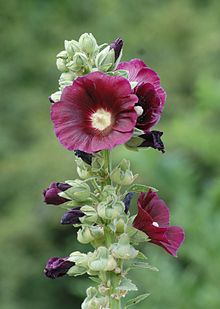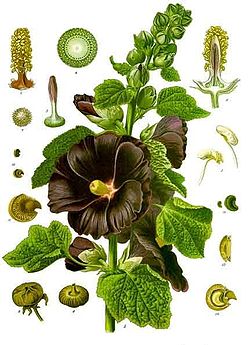- Alcea rosea
-
Alcea rosea 
Scientific classification Kingdom: Plantae (unranked): Angiosperms (unranked): Eudicots (unranked): Rosids Order: Malvales Family: Malvaceae Genus: Alcea Species: A. rosea Binomial name Alcea rosea
L.Alcea rosea (Common Hollyhock; syn. Althaea chinensis Wall., Althaea ficifolia Cav., Althaea rosea Cav.) is an ornamental plant in the Malvaceae family.
It was imported into Europe from southwestern China during, or possibly before, the 15th century.[1] William Turner, an herbalist of the time, gave it the name "holyoke" from which the English name derives.
Contents
Cultivation
Alcea rosea is variously described as a biennial (having a two-year life cycle), as an annual, or as a short-lived perennial.[2][3][4] It frequently self-sows, which may create a perception that the plants are perennial.[2] The plant may flower during its first year when sown early.[3] It will grow in a wide range of soils, and can easily reach a height of about 8 ft. The flowers are a range of colours from white to dark red, including pink, yellow and orange. Different colours prefer different soils. The darker red variety seems to favour sandy soils, while the lighter colour seems to favour clay soils.[5] The plants are easily grown from seed, and readily self-seed. However, tender plants, whether young from seed or from old stock, may be wiped out by slugs and snails. The foliage is subject to attack from rust (Puccinia malvacearum), which may be treated with fungicides.[6] Commercial growers have reported that some closely related species (Alcea rugosa and Alcea ficifolia) are resistant to this fungus.[7]
Herbalism
In herbal medicine, Hollyhock is believed to be an emollient and laxative. It is used to control inflammation, to stop bedwetting and as a mouthwash in cases of bleeding gums.[8]
Footnotes
- ^ "Flora of China 12: 267–268. 2007". Harvard University. http://flora.huh.harvard.edu/china//PDF/PDF12/Alcea.pdf. Retrieved 2011-07-21.
- ^ a b "Hollyhock". Cornell University. http://www.gardening.cornell.edu/homegardening/scene3280.html. Retrieved 2011-07-21.
- ^ a b "Annual - Hollyhock - Alcea rosea". University of Illinois. http://urbanext.illinois.edu/hortanswers/plantdetail.cfm?PlantID=2&PlantTypeID=1. Retrieved 2011=-7-21.
- ^ "Plant of the Month - Hollyhocks". New Mexico State University Master Gardener Newsletter. http://aces.nmsu.edu/county/donaana/mastergardener/documents/feb10-mg-newsltr.pdf. Retrieved 2011-07-21.
- ^ Observation of dark red and "apple blossom" pale pink side by side in Birmingham and Christchurch, Dorset.
- ^ "Hollyhock rust". Cornell University. http://plantclinic.cornell.edu/FactSheets/hollyhockrust/hollyhockrust.htm. Retrieved 2009-07-15.
- ^ "Yard & Garden Line News". University of Minnesota Extension Service. 2005-06-15. http://www.extension.umn.edu/yardandgarden/YGLNews/YGLN-June1505.html. Retrieved 2010-02-05.
- ^ Howard, Michael. Traditional Folk Remedies (Century, 1987) p.155
References
- Alcea rosea. University of California Davis.
External links
Categories:- Malveae
- Flora of North Dakota
Wikimedia Foundation. 2010.

